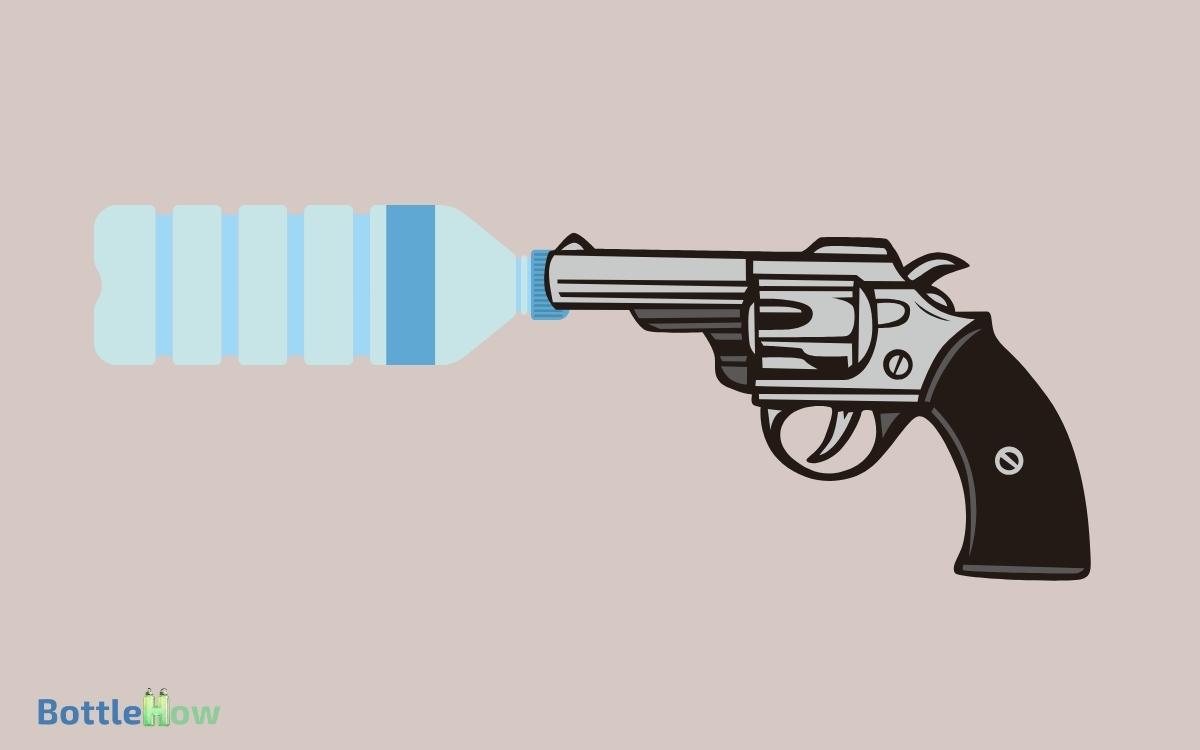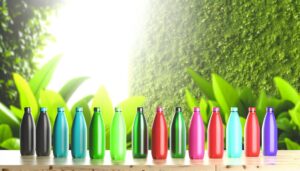Can You Make a Silencer Out of a Water Bottle? Yes!
You might think you can make a silencer out of a water bottle, but it’s not advisable. Water bottles aren’t designed to handle the high pressures produced by gunfire.
They can rupture, causing serious injury. Additionally, homemade silencers are often ineffective and can still produce significant noise.
Legally, creating or using an unregistered silencer can lead to severe penalties, including hefty fines and imprisonment. Commercial suppressors undergo rigorous testing to guarantee both effectiveness and safety.
For detailed insights into why this isn’t a safe or legal option, it’s essential to explore further information.

Key Takeaways
Understanding Silencers
A silencer, also known as a suppressor, is a device attached to or part of a firearm’s barrel that reduces the amount of noise and visible muzzle flash generated by firing. You’ll often find them used to minimize the acoustic footprint of a shot.
While they don’t make a firearm completely silent, they do greatly lower the decibel level. This reduction can be important for hearing protection and stealth.
Silencers are typically constructed from durable materials like steel or aluminum and contain internal baffles that slow and cool the escaping gases.
Understanding the basic function and construction of a silencer is essential before considering any alternative methods, such as using a water bottle. Always approach such topics with caution and respect for legal regulations.
How Silencers Work
Silencers work by trapping and slowing the gases expelled when a firearm is discharged, significantly reducing noise and muzzle flash. When you fire a gun, hot gases rapidly expand, creating a loud sound.
A silencer, or suppressor, uses a series of baffles and chambers to control and cool these gases. This process decreases the sound signature, making the shot quieter.
Key points on how silencers function:
- Gases are trapped and slowed: Reducing their speed lessens noise.
- Cooling of gases: Lower temperature means less noise.
- Baffles and chambers: These components disrupt gas flow.
- Reduced muzzle flash: Less visible light from the gun’s muzzle.
Understanding these mechanisms is important before diving into materials and design aspects.
Materials and Design
You’ll need to carefully select materials and design features to create an effective silencer using a water bottle.
- First, choose a sturdy plastic bottle as your base; flimsy ones won’t withstand the pressure.
- Next, you’ll want to insert sound-dampening materials like steel wool or rubber washers inside the bottle. These materials help absorb and reduce the noise.
- Guarantee the bottle’s neck fits snugly over the firearm’s barrel to prevent gas leakage.
- Drill precise holes in the bottle to allow gas to escape gradually, further reducing noise.
Water Bottle Basics
When choosing a water bottle for this project, you should take into account the type of bottle, its material, and its size.
Different materials such as plastic or aluminum will impact the performance and durability of your silencer. Make sure the bottle’s capacity aligns with your design requirements for best functionality.
Types of Water Bottles
Understanding the different types of water bottles is essential when considering their use in constructing a silencer.
You need to be aware of the various options available and their specific characteristics. Each type can influence the effectiveness and feasibility of your project.
Consider the following types:
- Plastic Bottles: Lightweight and easy to modify, but they mightn’t withstand high pressure.
- Metal Bottles: More durable and resistant to pressure, yet harder to cut and shape.
- Glass Bottles: Provide rigidity, but are prone to shattering.
- Disposable Bottles: Convenient and readily available, but often flimsy.
Selecting the right type is critical for success. Each has pros and cons, and your choice can greatly impact the outcome. Understanding these basics will guide you in making an informed decision.
Material Considerations
Choosing the right water bottle for a makeshift silencer requires careful consideration of its material properties and structural integrity.
You should focus on bottles made from durable plastics like PET or HDPE, as these materials can withstand the pressure and heat generated during firing. Avoid thin, flimsy bottles that might collapse or melt.
Additionally, consider the bottle’s wall thickness; thicker walls provide better sound dampening and structural stability.
You should also inspect the bottle for any defects or weaknesses, like cracks or thin spots, which could compromise its performance.
Size and Capacity
After selecting a durable water bottle material, you need to contemplate its size and capacity to guarantee it will effectively reduce sound without compromising safety.
The dimensions and volume of the bottle play an important role in its performance as a makeshift silencer.
Here are key factors to take into account:
- Length and Diameter: A longer and wider bottle may provide better sound suppression but could be more cumbersome.
- Volume Capacity: Larger capacity can trap more gas, aiding in noise reduction.
- Fit to Barrel: Make sure the bottle’s opening aligns well with your firearm’s barrel to avoid accidents.
- Weight: Heavier bottles might affect handling and balance.
Carefully evaluating these aspects ensures you achieve the desired sound suppression while maintaining safety.
The Myth of DIY Silencers
You might think making a silencer out of a water bottle is a quick fix, but it’s fraught with problems.
Not only is it often ineffective and dangerous, but it also carries serious legal repercussions. Understanding these risks is essential before considering such an endeavor.
Ineffectiveness and Danger
Despite the allure of easy solutions, attempting to make a silencer out of a water bottle is both ineffective and dangerously misleading.
The science behind sound suppression involves complex engineering that a simple water bottle can’t replicate.
Here are key points to take into account:
- Inefficiency: Water bottles lack the materials and design needed to markedly reduce noise.
- Safety Risks: Improvised devices can malfunction, causing injury.
- Durability Issues: A water bottle can’t withstand the pressures and temperatures generated by firing a gun.
- Noise Level: The sound suppression is minimal, rendering the effort pointless.
Understanding these points helps you grasp why DIY silencers aren’t just impractical but also hazardous. Always prioritize safety and reliability in handling firearms.
Legal Consequences
Apart from the physical dangers, attempting to make a silencer out of a water bottle also brings serious legal consequences.
In the United States, the National Firearms Act (NFA) regulates the manufacture and possession of silencers.
Creating a homemade silencer, even from common household items, is illegal without prior approval from the Bureau of Alcohol, Tobacco, Firearms and Explosives (ATF). Violating these regulations can result in severe penalties, including hefty fines and imprisonment.
You should understand that even mere possession of an unregistered silencer can lead to federal charges. It’s essential to recognize that these laws are strictly enforced, and ignorance isn’t a valid defense.
Always prioritize legal compliance over risky, uninformed experiments.
Practical Challenges
One significant challenge in making a silencer out of a water bottle is ensuring it can withstand the pressures and temperatures generated during firearm discharge. A standard water bottle isn’t designed to handle such extreme conditions.
You’ll encounter several practical hurdles:
- Material Integrity: Plastic bottles can easily melt or deform.
- Sound Suppression: A water bottle’s structure doesn’t effectively dampen sound.
- Attachment: Securing the bottle to the firearm is both tricky and unstable.
- Durability: The bottle will likely fail after just a few shots.
These challenges make using a water bottle as a silencer impractical. It’s important to understand that the materials and engineering behind legitimate firearm silencers are highly specialized and rigorously tested for safety and effectiveness.
Safety Concerns
Ensuring safety is paramount when attempting to create a makeshift silencer, as improper materials and construction can lead to catastrophic failure.
A water bottle isn’t designed to withstand the high pressures and temperatures generated by a firearm discharge. Attempting to use a water bottle in such a way could cause it to rupture or melt instantly, leading to dangerous consequences. Unlike materials engineered for high-stress applications, plastic bottles lack the necessary strength and heat resistance. If you’re wondering, can you put soda in a bottle, the answer is yes—but only for its intended purpose, not extreme pressure scenarios.
Using it as a silencer can cause it to rupture, sending sharp fragments flying, which can result in serious injury. Furthermore, the sound suppression might be inadequate, causing hearing damage.
You should never underestimate the destructive potential of a failed silencer. Always prioritize proper materials and professional methods if you’re considering sound suppression.
It’s essential to remember that makeshift solutions often lack the necessary engineering and safety assurances found in commercially produced devices. Your safety should never be compromised.
Legal Issues
You need to be aware that federal firearms regulations strictly control the creation and possession of silencers.
Additionally, state-specific laws can vary widely, making it essential to understand the legal landscape in your area.
Violating these laws can result in severe legal penalties, including hefty fines and imprisonment.
Federal Firearms Regulations
Understanding federal firearms regulations is vital when contemplating any modifications to a firearm, including the creation of a homemade silencer.
Under federal law, silencers are classified as ‘firearm mufflers’ and are heavily regulated by the National Firearms Act (NFA). Failure to comply with these regulations can result in severe penalties.
Key points to take into account include:
- Registration: All silencers must be registered with the Bureau of Alcohol, Tobacco, Firearms, and Explosives (ATF).
- Tax Stamp: You need to pay a $200 tax stamp for each silencer.
- Background Check: A thorough background check is mandatory.
- Manufacturing: Making a silencer, even for personal use, without proper authorization is illegal.
Being informed and compliant is essential to avoid legal repercussions.
State-Specific Silencer Laws
Understanding state-specific silencer laws requires careful attention to the unique regulations and restrictions each state imposes. While federal laws provide a baseline, states can vary greatly.
In some states, silencers are legal for hunting and personal use if you comply with federal guidelines. However, other states, like California and New York, have outright bans on silencer possession and usage.
You’ll need to research your state’s specific laws and possibly consult legal counsel to guarantee compliance. Additionally, states may have varying requirements for transporting silencers across state lines.
Ignoring these distinctions could lead to severe legal consequences. Always verify with local authorities or legal experts before considering any actions involving silencers to stay within the law.
Legal Penalties Involved
Violating silencer laws can lead to severe legal penalties, including hefty fines and imprisonment. It’s important to understand the risks involved if you’re considering making or possessing a homemade silencer.
Federal and state laws are stringent, and ignorance won’t exempt you from punishment.
You could face:
- Fines up to $250,000 for individuals
- Imprisonment up to 10 years for each offense
- Permanent crime record affecting future opportunities
- Confiscation of firearms and related equipment
Authorities don’t take these violations lightly, and enforcement is rigorous. Always make sure you know and comply with all applicable laws.
It’s not just about avoiding penalties; it’s about maintaining public safety and responsible gun ownership.
Real-World Examples
In some instances, individuals have attempted to create makeshift silencers using water bottles, often with varying degrees of success and legality. You might find videos or anecdotes online showcasing these improvised methods.
The results vary widely, with some claiming a slight reduction in noise and others experiencing negligible effects. It’s important to understand that such attempts aren’t only unreliable but also illegal in many jurisdictions.
Law enforcement agencies have reported confiscating these makeshift devices during investigations.
Even if the intention is curiosity or experimentation, the legal implications are severe. Always remember, the effectiveness and legality of using everyday items as firearm suppressors are highly questionable and potentially dangerous.
Expert Opinions
Given the risks and legal issues surrounding makeshift silencers, let’s see what experts in firearms and law enforcement have to say about this topic.
Experts generally advise against attempting to create a silencer out of a water bottle due to several critical reasons:
- Legal Consequences: Possessing or using an unregistered silencer is a federal offense, leading to severe penalties.
- Effectiveness: Makeshift silencers are often ineffective, failing to noticeably reduce noise.
- Safety Concerns: Homemade silencers can malfunction, potentially causing injury.
- Professional Advice: Experts recommend using legally approved and commercially available silencers for both safety and compliance.
Alternative Noise Reduction Methods
For those looking to reduce firearm noise legally and safely, there are several effective alternatives to makeshift silencers.
You can purchase commercial suppressors, which are specifically engineered to reduce noise and are subject to stringent regulations, guaranteeing both effectiveness and legality.
Another option is using subsonic ammunition, which operates below the speed of sound and generates less noise compared to standard rounds.
Additionally, you might consider sound-dampening shooting ranges designed to contain and minimize firearm noise.
Investing in high-quality ear protection, such as electronic earmuffs, can also greatly reduce perceived noise levels.
Conclusion
Imagine the soft whisper of a breeze compared to the crack of thunder. While the idea of crafting a silencer from a water bottle might seem intriguing, it’s fraught with myths and legal pitfalls.
You’re better off exploring legitimate noise reduction methods. Remember, the law doesn’t take DIY silencers lightly. Always prioritize safety, legality, and expert advice when considering firearm modifications.
It’s not worth risking severe consequences for a fleeting notion.





